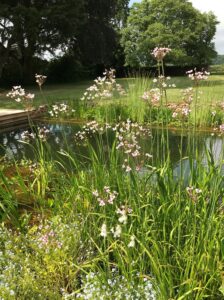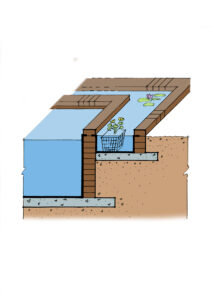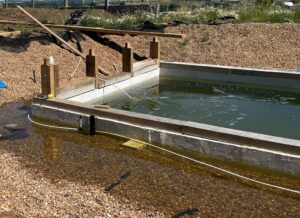Hello everybody
2024 is here at last; I think we are all looking forward to a break from all the depressing news which has assailed us for the last three years, not sure we’re going to get one though. One sure way to relieve stress levels is to introduce water into your environment in the form of a garden pond or even possibly a natural swimming pond.

We are getting more and more enquiries about the latter, often at the stage when the construction is complete and the main question is “What plants can we use?” In a number of cases this has involved considerable extra work for the customer, who has not appreciated the requirements of the plants when drawing plans or building the pool, and who has therefore provided shelves at the wrong depth, insufficient planting zones or a poor choice of planting medium. I thought I would take the opportunity to explain some of the common issues so that those of you who are planning a build can avoid costly and annoying changes at the last minute.
Firstly, the basic principle of a natural swimming pond is that sufficient plants are provided to carry out the water purification normally achieved by use of swimming pool chemicals. The aim is to create a volume of water that contains very few of the nutrients which would encourage the growth of algae, specifically nitrates and phosphates. The pond plants require some of these nutrients to survive and look green and healthy, so there is an obvious contradiction here. The key is to allow sufficient nutrients in the planting medium to be found and locked up by the plant roots, but very low levels of nutrients dissolved in the water. In order to work, a substantial number of plants are needed, in most cases about half of the available pond surface area should be occupied by plants. The plants are most often grown in clean coarse grit or gravel, which prevents the introduction of unwanted nutrients, though it is perfectly possible to use soil, provided that is of suitable quality and covered by a thick layer of gravel after planting. Sticky yellow London clay is unsuitable, but if you have a sandy or medium clay subsoil, then the layer 10-20cm below the soil surface can often be used. It must be lightly compacted before planting and covered with at least 5cm of clean gravel before wetting to avoid leaching into the water, thereby causing a murky pond and nutrient release. Designers and contractors vary in their approach to this and it is somewhat a matter of personal choice. If a geotextile liner has been used, it will be necessary to use at least 30cm of covering soil or gravel, but if a rubber type liner is installed then 15-20cm cover should suffice but gravel is to be used in preference to soil.

My own view is that marginal plants should either be introduced already established in mesh pots and lightly washed before plunging into a gravel substrate, with or without the pot, or planted bare rooted and direct into gravel of about 10mm diameter. Please consider using larger plant specimens, as the established root ball will contain few free nutrients and the roots will quickly spread beyond the pot to lock up free nutrients in the intersticial spaces of the planting medium. For me, water lilies should always be initially introduced in pots since they do poorly if planted as bare root specimens directly into gravel; they are heavy feeders. In an ideal world, the planted area is contained within a completely separate regeneration zone, through which the water is continuously drawn by pumps of some sort, but due to space and budget constraints it is common to find a central or offset swimming zone within or adjacent to the planted zones. The benefit of a separate zone is that it can be broad and shallow and totally filled with plants without detrimentally affecting visual aspects or access of the swimming zone.

Once the decision regarding planting medium has been made, it allows a retro calculation of the shelf depths and positions. If using soil on top of a geotextile liner, a minimum of 30cm cover is necessary, but if using gravel on top of a rubber liner 20cm is more usual. IMPORTANT: The most common problem we see, and we do see this time and again, is that the marginal shelves are either too deep, or steeply sloping, or both. This is not helped by the profusion of drawings, mostly created by architects rather than plant experts, showing a central swimming zone 2m or so deep, surrounded by a concrete or timber wall whose top is about 60m below water level, surrounded by a gravel covered margin sloping at about 1 in 3 up to the surface. Not only is this much too steep to prevent the gravel from moving steadily downhill, but it means that the zone available for suitable marginal plants is just a narrow fringe around the perimeter. MANY OF THE MOST ATTRACTIVE MARGINAL PLANTS GROW BEST AT DEPTHS OF 0 TO 10CM. Quite a number of marginal plants will grow deeper than this, but those that do are mostly unsuitable for ponds of this size, being invasive, vigorous or aggressive, sometimes having sharp shoots or roots which can penetrate the waterproofing membrane.
So, for the best results and greatest flexibility with the planting scheme, please plan your shelves to be very broad – at least a metre but preferably 2 to 3 metres, and at a finished depth of 0-10cm FROM THE TOP OF THE COVERING OF SOIL OR GRAVEL to the water level. That way you will have a much longer list of attractive and non-invasive marginal plants to choose from and your gravel won’t all end up in the bottom of the swimming zone. This primary marginal shelf can then drop to a deeper shelf at 30 to 60cm on which water lilies can be placed before dropping to the full swimming depth. Confine any slopes to the access to the deepest area where they can remain unplanted.
If you’re planning a project like this, please do get in touch with us at an early stage. My recently published book contains a lot of helpful detail and may save you time and money too! You can buy it from my website or from Amazon and bookshops too.
In my next article I will provide more detail on plant selection for natural swimming ponds. Happy days!

